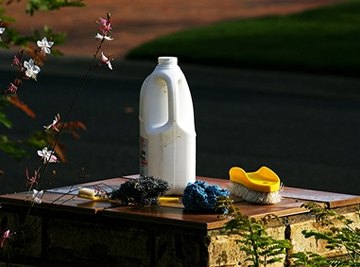
Most homeowners do not think twice before using bleach on clothing and other articles without realizing its harmful effects. Bleach gives off toxic fumes, which are extremely dangerous. While it effectively removes even the toughest of stains, it damages fabrics in the long run, often permanently, and its effects continue long after the fabric has been washed and rinsed. Bleach needs to be neutralized after it has accomplished its intended purpose. Bleach neutralizers refer to chemicals that neutralize the harmful effects of sodium hypochlorite, commonly known as bleach.
Sodium Metabisulfite
Sodium metabisulfite (chemical formula Na2S2O5) is also called disodium disulfite, pyrosulfurous acid and disodium salt. It is often used in the dechlorination of swimming pools, or to lower its chlorine levels. Water treatment plants employ the substance to remove trace of excessive chlorine. Sodium metabisulfite is an effective bleach neutralizer. 2.2 grams (one teaspoon) of sodium metabisulfite added to 2.5 gallons of water effectively neutralizes all harmful bleach residue.
Sodium Sulfite
Sodium sulfite (chemical formula Na2SO3) is an effective, fast and cheap bleach neutralizer that is easily available at most swimming pool chemical vendors. It is typically used to stabilize high levels of chlorine in a swimming pool, and is sold under the trade names De-Chlor and Knock Down.
Ascorbic Acid
Ascorbic acid (chemical formula C6H8O6) is used commercially to neutralize bleach in water storage tanks. Bleach, which is added to water tanks as a disinfectant, needs to be completely eliminated before the water is fit for drinking or agricultural purposes. Ascorbic acid neutralizes all residual bleach in a matter of seconds, and 1/4 tsp. of the substance added to 1 gallon of water effectively removes all traces of bleach.
Sodium Thiosulfate
Sodium thiosulfate (Na2S2O3) is used in spas to lower bromine and chlorine levels. It is a valuable bleach neutralizer, and is just as effective as sodium metabisulfite, even though it is slightly more expensive.
Caution
Acids besides those mentioned in this article should not be used in an effort to neutralize bleach. Vinegar is one such substance that is erroneously purported to have a neutralizing effect on bleach. Instead, vinegar acts on the hypochlorite content of bleach, turning it into hypochlorous acid and other dangerous chemicals. Hypochlorous acid can convert to deadly chlorine gas in a low pH solution.
According to Rayna Gillman in the book “Create Your Own Hand Printed Cloth,” hydrogen peroxide is an ineffective bleach neutralizer—contrary to popular opinion.
References
- Argonne National Laboratory: Bleach Neutralizers
- GemWater: Disinfecting with Bleach
- "Create Your Own Hand-Printed Cloth"; Rayna Gillman; 2008
About the Author
Natasha Gilani has been a writer since 2004, with work appearing in various online publications. She is also a member of the Canadian Writers Association. Gilani holds a Master of Business Administration in finance and an honors Bachelor of Science in information technology from the University of Peshawar, Pakistan.
Photo Credits
cleaning mailbox 2. image by mdb from Fotolia.com
